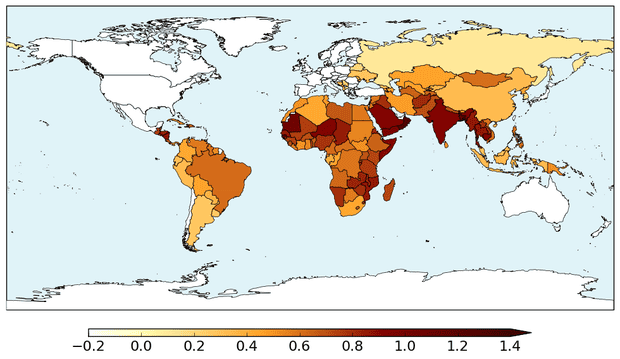
We have delayed action for so long on handling climate change, we now can no longer can “will it happen?” Rather we have to ask “how bad will it be?” and “what can be done about it?” As our society thinks about what we should do to reduce our carbon pollution and the consequences of electing science-denying politicians, scientists are actively studying the pros and cons of various emission reductions.
Readers of this column have certainly heard about temperature targets such as 1.5°C or 2°C. These targets refer to allowable temperature increases over pre-industrial temperatures. If humans take action to hit a 1.5°C target, it means we are committed to keeping the human-caused global temperature rise to 1.5°C. Similarly for a 2°C target.
The lower the target, the smaller the climate change. The smaller the climate change, the better. But is it worth the effort to set lower targets? I mean, if 2°C is good enough, why take the trouble to keep temperatures within 1.5°C?
Fortunately, a new paper just out in the Philosophical Transactions of the Royal Society A asks this question. Specifically, they ask “How much larger are the impacts at 2°C compared to 1.5°C?” A follow-on question asked by the authors relates to what conditions occur at a particular level of warming, such as 2°C. This is a really important question because policymakers need to know what it will take to adapt to a 1.5°C world or a 2°C world.
The authors focus on the impact of climate change on food security, and in particular, how changes to extreme weather will impact food production. The weather issues that are central to this study are drought and precipitation. We know that in a warming world, the weather will get wetter. This is because warm air is more able to hold water (air can be more humid). As a consequence, when rains fall, they come in heavier bursts. We are already seeing this in the US, for example, where the most extreme rainfalls are increasing across the country.
So, there are competing issues and an obvious question is, which will win out? Will the world become drier or wetter? The answer to this question depends on where you live. It is likely that areas that are currently wet will become wetter. Areas that are currently dry will become drier. This is just a general rule of thumb, there are variations to this rule. But it is a pretty good generalization.
This behavior is vexing for farmers because it makes planning for the future complicated. But this study at least shines some light on the subject and helps us prepare. To complete the study, the authors considered an Earth that has 1.5°C warming and another Earth with 2°C warming. The authors then identified specific measures for extreme weather. Among the measures are the annual maximum temperature, the percentage of days with extreme daily temperatures, the number of consecutive dry days, and the maximum rainfall in a 5-day period.
Measures of heavy rainfall and drought were combined with societal factors to form a Hunger and Climate Vulnerability Index. The index incorporates how exposed a country is to climate hazards, how sensitive a country’s agriculture is to climate hazards, and how able a country is to adapt. With these metrics and indices calculated for 122 countries in the developing and under-developed parts of the globe, the authors show that some areas will be more impacted than others.
Increased wetness will affect Asia more than other regions. Among their predictions is that the water flowrate in the Ganges river may increase by 100%. However, increases to drought could hit Africa and South America hardest. An example outcome is that the Amazon river flow may decrease by 25%. They also found that for most of the planet, a 2°C world is worse than a 1.5°C world. This is to be expected, but now there is a way to quantify the impact of incremental increases in temperature on societal impact.
When the authors continued their look at various regions, that found that temperature changes are amplified in some locations. For instance, with a 2°C warmer world, the land areas mostly warm by more than 2°C. In some regions, like North America, China, northern Asia, northern South America, and Europe, the daily high temperature increases could be double that of the globe on average.
In the figure below, the Hunger and Climate Variability Index is shown for a 2°C warmer world. The image is scaled according to how vulnerable they are to food insecurity. Countries with a larger value are more vulnerable than countries with a smaller number. Any country with a vulnerability greater than 1 is more vulnerable than any country today.

Hunger and Climate Vulnerability Index for 2°C global warming. Illustration: Betts et al. (2018), Philosophical Transactions of the Royal Society A
As lead author Richard Betts explained,
Posted by John Abraham on Tuesday, 3 April, 2018
 |
The Skeptical Science website by Skeptical Science is licensed under a Creative Commons Attribution 3.0 Unported License. |